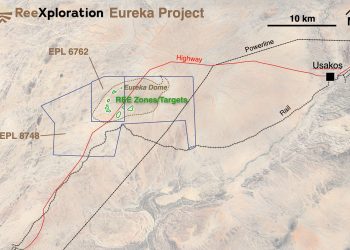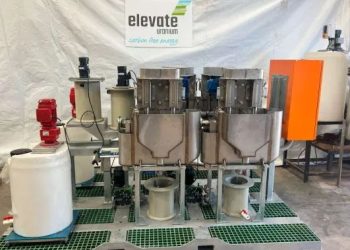
Paladin Energy has announced a capital expenditure allocation of N$477 million (US$26 million) for the fiscal year 2025 (FY2025) to ramp up production at its Langer Heinrich Mine (LHM) in Namibia.
This strategic investment follows the successful completion of the mine’s restart project and the recommencement of commercial production in March 2024.
After a period of dormancy, the Langer Heinrich Mine is set to become a significant player in the uranium market once again. Full-scale mining activities are expected to resume in FY2026. However, the mine is projected to achieve substantial production levels as early as FY2025, with higher volumes anticipated in the latter half of the year.
“The LHM will be in operational ramp-up during FY2025, with ore feed to the plant sourced from previously mined stockpiled ore. Production levels are expected to be higher in the second half of the year. Mining activities are expected to recommence in FY2026 ahead of achieving nameplate production of 6 million pounds (Mlb) per annum by the end of calendar year 2026,” Paladin stated.
Paladin forecasts that production will fall within a range of 4.0 to 4.5 million pounds of uranium oxide (U3O8) for FY2025, with a plant recovery rate of 85-90%. This projection highlights the company’s confidence in the operational efficiency and the potential of the Langer Heinrich Mine to contribute significantly to the global uranium supply.
The company has also provided detailed cost expectations, estimating production costs between N$514 (US$28) and N$569 (US$31) per pound of U3O8. These costs encompass stockpile rehandling, processing, and site administration but exclude general and administrative expenses.
This cost structure is critical for stakeholders to understand the financial viability and profitability of the mine as it ramps up operations.
In a bid to provide a comprehensive financial outlook, Paladin conducted a uranium price sensitivity analysis. This analysis examines how varying uranium spot prices would impact the expected realized uranium price for FY2025, based on a sales volume of 4.1 Mlb.
The analysis assumes a fixed spot price throughout the year and deliveries based on existing contracts with some flexibility considered. This strategic approach helps in mitigating risks associated with price fluctuations in the uranium market.
The Langer Heinrich Mine, located in the Namib Desert, has historically been one of the world’s significant uranium producers. Its recommencement is not only vital for Paladin Energy but also for Namibia’s economy, as it contributes to local employment and economic activity. The mine’s restart and ramp-up are expected to bolster Namibia’s position in the global uranium market, providing a stable supply of uranium which is crucial for nuclear energy production worldwide.
Paladin Energy has emphasized its commitment to sustainable mining practices and community engagement. The restart project included measures to minimize environmental impact and ensure the health and safety of workers.
As operations scale up, the company plans to continue its focus on environmental stewardship and community development programs. This includes initiatives aimed at improving local infrastructure, education, and healthcare services, which are essential for the well-being of the surrounding communities.
Looking beyond FY2025, Paladin Energy aims to achieve nameplate production capacity of 6Mlb per annum by the end of calendar year 2026. This ambitious target aligns with the increasing global demand for uranium, driven by the need for clean and reliable energy sources. The resurgence of nuclear energy as a key component of the global energy mix presents a significant opportunity for uranium producers like Paladin.
The uranium market has shown signs of recovery in recent years, with prices gradually increasing due to a combination of supply constraints and growing demand.
Paladin’s strategic investments and operational efficiencies at the Langer Heinrich Mine position the company to capitalize on these market dynamics, ensuring a steady supply of uranium to meet the needs of the nuclear energy sector.







